Kuwait—2012 Article IV Consultation Concluding Statement of the IMF Mission
April 30, 2012
Describes the preliminary findings of IMF staff at the conclusion of certain missions (official staff visits, in most cases to member countries). Missions are undertaken as part of regular (usually annual) consultations under Article IV of the IMF's Articles of Agreement, in the context of a request to use IMF resources (borrow from the IMF), as part of discussions of staff monitored programs, and as part of other staff reviews of economic developments.
I. Introduction
1. An International Monetary Fund (IMF) mission visited Kuwait during April 18–30 to hold discussions for the 2012 Article IV consultation.1, 2 Discussions focused on near-term economic policies; medium term fiscal policy and the efficiency of government expenditure; and measures to enhance the business environment and maintain financial stability. The mission benefited from interactions with the Central Bank Governor, Minister of Commerce and Industry, Undersecretary of Finance, the Chairman of the Parliament’s Economic and Financial Committee, other government and central bank officials, and representatives of the private sector and civil society.
2. Kuwait had strong macroeconomic outcomes in recent years, but it still faces challenges to improve its physical and social infrastructure and to diversify its economic base. Kuwait has posted fiscal and external surpluses for thirteen years in a row, and maintained a largely stable macroeconomic environment. Nevertheless, it fares relatively low vis-à-vis international comparisons as regards the quality of its infrastructure, health, and education, taking into account its GDP per capita level (Figure 1). The economy remains oil dominated and the private sector is largely dependent on government spending and expatriate labor.3 The labor market is highly segmented: Kuwaiti nationals work primarily in the public sector—about 80 percent of the Kuwaiti labor force is employed in the public sector—and constitute only 7 percent of the private sector labor force, while expatriates are employed mostly in the private sector.4
3. A four-year Development Plan (DP) was launched in FY2010/11. The DP is the first of a series of plans based on a strategic vision for 2035 that emphasizes investment in infrastructure, health, and education, and envisages significant co-participation of the private sector through the establishment of public shareholding companies. In addition, the DP aims at diversifying Kuwait’s economy by transforming the country into a regional financial and trade hub.
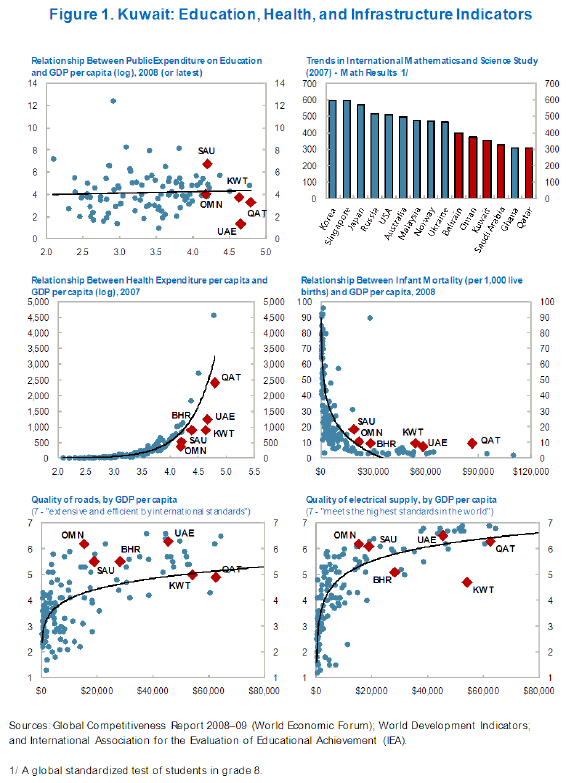
II. Recent Developments
Oil sector has expanded, but nonoil sector recovery is still moderate
4. The budget expansion in 2011 was more than offset by the increase in oil revenues. Government expenditure continued to increase in FY2011/12 (8 percent), reflecting, among other things, a significant increase in the wage bill (19 percent). Nevertheless, Kuwait benefited from an increase in oil prices in 2011, which, together with higher production intended to offset the loss of Libyan oil, resulted in a significant increase in oil receipts (35 percent). Overall, fiscal and external surpluses are estimated to have reached over 30 percent and 41 percent of GDP in 2011, respectively, and fiscal support to the economy—measured as the nonoil deficit to nonoil GDP, after adjusting for investment income and transfers to the pension fund—remained above historical figures, at 63 percent.
5. Notwithstanding significant fiscal support, the pace of recovery of nonoil economic activity has been moderate. The mission estimates nonoil growth in 2011 at about 4.5 percent, with still weak, although improved, growth of banks’ credit to the nongovernment sector of 2½ percent in 2011. Nevertheless, corporate earnings declined in all sectors with the exception of services;5 the banking sector maintained largely flat profits because of a buildup in provisions and the investment and real estate companies sectors posted losses (Figure 2). At the same time, real estate transactions recovered in the residential and investment segments, with the value of residential sales and the average transaction size increasing by 32 percent and 14 percent vis-à-vis 2010, respectively (Figure 3). Commercial real estate continues to suffer from low occupancy rates and significant declines in rental rates. Inflation remained moderate, supported by subdued domestic inflation.6
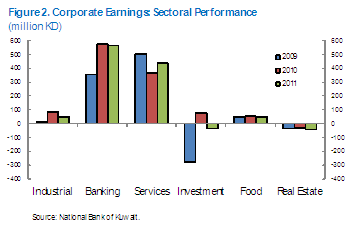
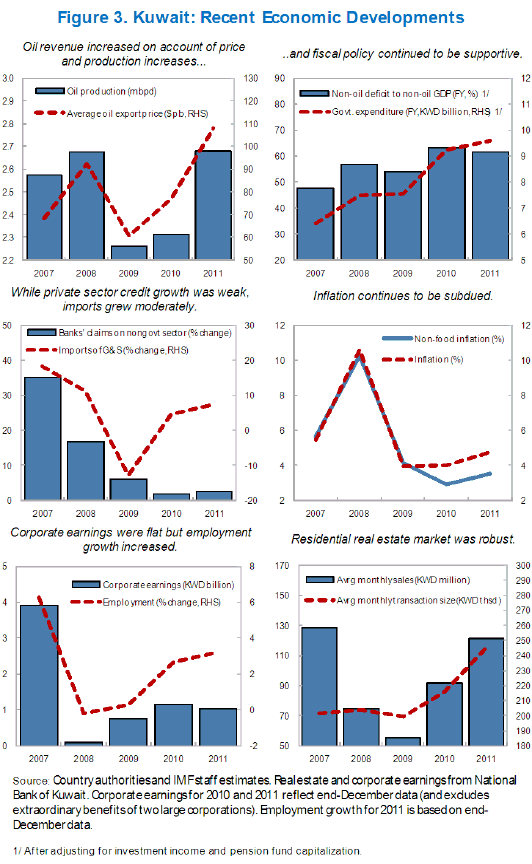
The banking sector is strong but investment companies’ conditions continued to worsen
6.Banks faced a mixed environment in 2011. On the one hand, liquidity conditions remained favorable and lending to some sectors strengthened compared to 2010 (e.g., credit to industry and to households) (Figure 4). Profits of the banking sector remained largely flat vis-à-vis the previous year because of a buildup in provisions, and banks continue to be well capitalized. On the other hand, investment companies (ICs) continued to face difficulties—coupled with a lack of improvement in the real estate companies sector and a decline of 16½ percent in the domestic stock market—forcing banks to take large provisions. Banks’ equity prices declined five percent in 2011, a much lower drop compared to the overall index (Figure 5).
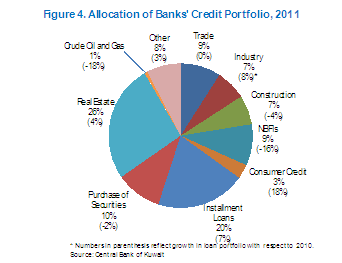
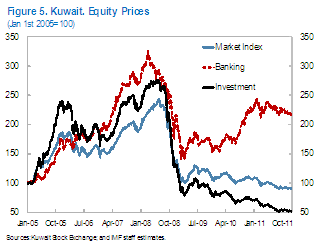
7. Investment companies came under renewed pressures. ICs have been under pressure since the beginning of the global financial crisis given their exposure to domestic, regional, and international equity and real estate markets and their dependence on short-term foreign lending.7 While there was some initial progress in ICs restructuring in 2009–10, the sector has hit renewed setbacks due to adverse market conditions in 2011 and the reemergence of global liquidity strains. Furthermore, nine companies were delisted from the Kuwait Stock Exchange (KSE) in Q1 2012 and 12 other companies that have been already suspended from trading were given final warnings to address their financial conditions by end-June 2011 or be delisted.8 The creditor protection clause under the 2009 Financial Stability Law has only been utilized in one case so far;9 only one restructuring was completed under the law, but it is yet to be seen if the restructuring plan will be executed successfully. Average equity prices of ICs declined almost 27 percent in 2011, which brings the cumulative decline vis-à-vis August 2008 to almost 79 percent.
III. Outlook and Risks
Economic recovery expected to strengthen, but low DP implementation rates and legislative bottlenecks could dampen the recovery
8. Economic recovery is expected to strengthen, led by high government expenditure. Nonoil economic activity is expected to expand about 5½ percent in 2012 as the expansion in government expenditures—particularly wages and capital expenditure—continue to filter through the economy. In addition, due to the persistence of high oil price and production levels, Kuwait is expected to attain fiscal and external surpluses of over 30 percent and 40 percent of GDP, respectively, for the second year in a row. Inflation is expected to moderate slightly in 2012 to about 4.4 percent, due to a decline in global food inflation.
9. Low capital budget implementation rates could hamper the recovery and undermine the objectives of the DP. Cross-country comparison indicates that Kuwait’s overall investment levels are relatively low (Figure 6), which points to the need for an increase in investment rates if the needed improvements in the country’s physical and social infrastructure were to be achieved. On the public sector side, the implementation of the capital expenditure budget has been only in the 75–80 percent range in recent years, and is estimated to have fallen below this range in FY2011/12. Project implementation has been generally delayed by red-tape and bureaucracy, an outdated legislative base, deficiencies in laws that have been passed in recent years, and holdups in passing new legislation. Overall, slippage in capital expenditures could hamper the recovery— capital expenditure has high growth multipliers and also helps catalyze private investment, particularly in the context of the DP.
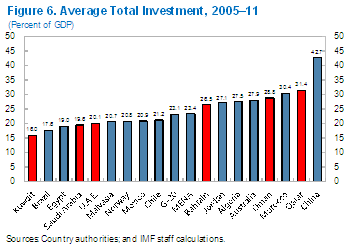
The economy remains exposed to external and domestic risks
10. Similar to other countries, Kuwait is exposed to external risks, including the intensification of the European debt crisis.
• Kuwait has accumulated a significant stock of financial assets, which provides it with a financial cushion to smooth out the impact of a temporary decline in oil prices. Nevertheless, a worsening of the sovereign debt crisis in Europe could result in a tail risk event of a protracted period of low oil global demand and prices and a further tightening of global financial markets. A materialization of this risk could impact Kuwait’s fiscal and external revenues and the private sector’s debt roll-over risk, further weakening the financial situation of investment companies.
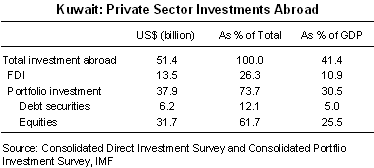
• Adverse external shocks could also affect Kuwait’s cross-border investments. Kuwait has sizable wealth held abroad. In addition to the Kuwait Investment Authority’s (KIA) assets,10 Kuwait’s cross-border private sector investments were estimated at over $51 billion in 2010 (41percent of 2010 GDP).11 In this context, a regional or global event could affect Kuwait’s public and private sector investments abroad, with a particular impact on ICs. Based on available data, the geographic allocation of Kuwait’ private sector cross-border assets is as follows:
- The majority of investments are in the GCC (about 40 percent of portfolio investment and 50 percent of FDI). The large share of private sector investment in the GCC renders Kuwait specifically vulnerable to financial market fluctuations in the region.12
- The private sector’s exposure to the rest of the MENA region is relatively small (7 percent of portfolio investment and 20 percent of FDI). Accordingly, the impact of developments in Arab countries undergoing transition on Kuwaiti private sector investments is estimated to be limited in view of relatively small exposures.
- A confined event in the GIIPS (Greece, Ireland, Italy, Portugal, and Spain) would have a limited impact on Kuwait’s private sector investment as its exposure to these countries is relatively small.
• Geopolitical events that could impact Kuwait’s oil export lines also constitute a risk.
11. A reversion to domestic political gridlock could hamper the recovery. The overarching issue for Kuwait is the ability of the government and parliament to push an agenda that improves the investment climate and promotes sustainable and inclusive growth. A lack of progress on this agenda could continue to slow down the implementation of the DP and, therefore, weaken the government-led recovery.13 Private sector investment would also be affected, both on account of the private sector’s co-participation in several DP projects and the likely worsening of the business environment.
| Kuwait: Risk Assessment Matrix | ||
|
Nature/Source of Main Threats |
Likelihood of realization in the next three years |
Expected impact on the economy if risk is realized |
|
Large and prolonged decline in oil prices The economy remains highly dependent on oil for its fiscal and external revenues. |
Mission assessment: Low A global recession followed by a protracted slow growth would depress demand for energy and could lead to a sharp fall in oil prices. |
Mission assessment: Medium to High While the government has buffers, some consolidation in expenditure would be required, which would affect nonoil activity. |
|
Worsening global and regional markets and financing conditions Kuwait’s private sector (particularly ICs) and government have sizable external financial and real exposures. ICs continue to be dependent on foreign financing. |
Mission assessment: Low to medium Stress in the Euro zone and regional developments could affect market valuation and financing conditions. |
Mission assessment: Low to medium ICs could be significantly affected by this scenario. Banks’ provisions would need to increase further, tightening domestic lending conditions due to higher risk aversion. But the banking system would likely remain sound, as banks have been provisioning for their lending to ICs for several years now. Impact on government’s assets is expected to be manageable. |
|
A slowdown in the implementation of the DP Nonoil growth is highly dependent on government expenditures, particularly in the context of the DP. |
Mission assessment: Low There have been significant delays in the implementation of the DP in the first two years of the plan. Furthermore, a number of recently-passed key laws proved to be deficient and now require amendments, and other needed legislation has been delayed. |
Mission assessment: Low to Medium Nonoil economic growth is dependent on government expenditure and further delays in the implementation of the DP and structural reforms would slow growth. |
IV. Policy Discussions
A. Near-Term Macroeconomic Policy Mix
12. Overall, the near-term fiscal policy stance is expected to remain supportive. Compared to the previous fiscal year, there is likely to be a fiscal stimulus of 4.7 percentage points in the non-oil primary deficit (Figure 7) and the deficit will remain significantly above pre-crisis levels. While the supportive fiscal stance is appropriate and has been called for in recent years in view of still moderate economic growth and low inflationary pressure, the composition of these increases,14 including in 2012/13, raises concerns both as regards medium-term fiscal sustainability (see Section B below), and short-term fiscal management. On the latter, the recurrent nature of these expenditures complicates the ability of the government to withdraw fiscal stimulus, if needed. While inflation is projected to remain low, inflation risk is on the upside and the authorities should be ready with a strategy for fiscal adjustment if inflationary pressures were to build up. This strategy should safeguard the capital budget as much as possible.15
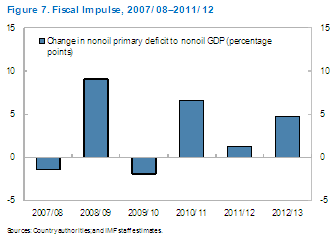
13. Monetary policy and liquidity conditions remain supportive. Policy interest rates are expected to remain historically low—consistent with Kuwait’s high degree of free capital mobility, the currency basket peg, and low international interest rates.16 Currently liquidity conditions are appropriately supportive of a strengthening of private sector credit growth. In view of the limitations of monetary policy in the context of the exchange rate peg, macroprudential policies (e.g., loan-to-deposit ratio, liquidity ratios, household debt-service ratio) gain importance in managing domestic liquidity and credit conditions, when needed. Nevertheless, in current conditions where inflationary pressures are likely to emanate from wage increases with still weak credit growth, the capacity of macroprudential policies to moderate these pressures would likely be limited.
14. Assessments of the real exchange rate suggest that the Dinar is broadly in line with fundamentals. The methods based on current account assessment give mixed results, as the underlying current account: (i) is somewhat higher than the norm suggested by the macro-balance approach (hence suggesting an undervaluation), but (ii) is smaller than the norm suggested by the external sustainability approach (hence suggesting some overvaluation). The method based on a direct assessment of the real exchange rate (i.e., the equilibrium real exchange rate approach) suggests a slight undervaluation. Taken together, this evidence suggests that the real exchange rate is in line with fundamentals, as the deviations of the real exchange rate and the current account from their benchmarks are low or moderate.
B. Maintaining a Sustainable Medium- to Long-Term Fiscal Envelope While Improving the Efficiency and Welfare Impact of Government Expenditure
15. Kuwait’s has significant fiscal space. Kuwait has a sound fiscal buffer, thanks to thirteen consecutive years of fiscal surpluses. In addition, while the FY2011/12 fiscal break-even oil price of $44 per barrel is much higher than the fiscal break-even price of $17 per barrel just before the global financial crisis (FY2007/08),17 the ratio of the break-even price to current market prices remains similar to historical standards.
16. Nonetheless, rising public sector wage and pension costs and rapid population growth are expected to exert pressures on public finances. The average real and nominal growth rate of the public sector wage bill has more than doubled in the last six years (2006/07–2011/12), to 8 percent and 13 percent, respectively (Figure 8). The continuation of such a trend could put significant pressures on government finances—via higher wage payments, government pension contributions, and an increase in the unfunded liabilities of the pension system—and would be difficult to reverse if oil prices were to decline significantly in the future. The cost to the pension system is onerous for Kuwait, particularly given its low retirement age (see Annex 1) and generous benefits.18 Finally, rapid population and labor force growth—about 60 percent of the Kuwaiti population is under 24 years—is likely to put increasing pressures on public sector employment and the provision of public services going forward.
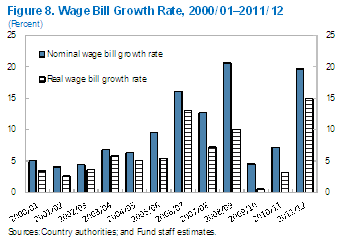
17. Fiscal consolidation is therefore needed in the medium term if current spending trends continue. The mission estimates that government expenditure will exhaust all oil revenues by 2017, which means that the government will not be able to save any portion of these revenues for future generations (Figure 9).19 In this context, medium-term benchmarks for government expenditure can help the government determine its fiscal envelope in order to target intergenerational equity in the distribution of oil resources. Kuwait’s nonoil primary deficit is already above the estimated baseline benchmarks (based on the permanent income hypothesis), and some fiscal consolidation would be needed in the medium to long term (Figure 10, upper panel). In this context, an adjustment of at least 12 percentage points of the nonoil primary deficit to GDP (or KD 7 billion against a projected expenditure of around KD 25 billion in 2017) would be needed by 2017 to ensure long-term fiscal sustainability. The need for fiscal consolidation is larger and more urgent in a scenario of lower oil prices (Figure 10, lower panel).
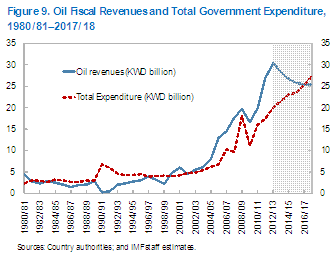
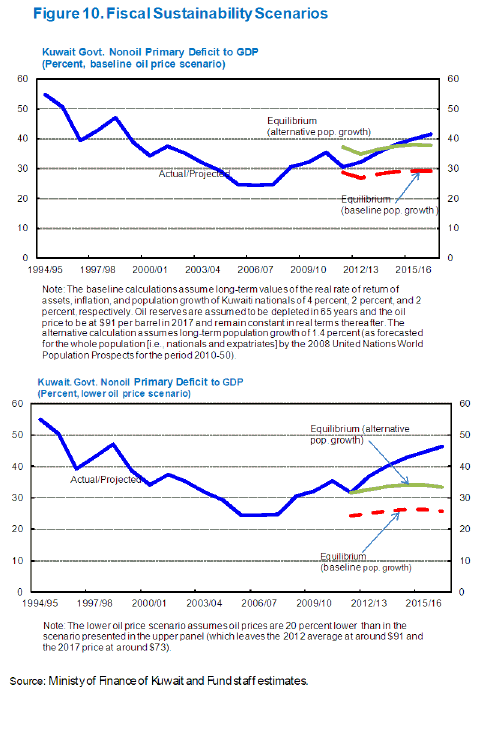
18. Overall, there is need to improve the productivity and welfare impact of government spending. In particular:
- Reallocating government expenditure towards capital expenditure, which has higher growth multipliers, would enhance nonoil GDP growth and improve the long-term sustainability of the fiscal accounts, while improving the productivity of government expenditure. In addition to containing the growth of the public sector wage bill, the authorities could consider increasing individuals’ pension contributions to avoid a further buildup of unfunded liabilities, and should avoid adopting any measures that would further burden public finances. Furthermore, while capital expenditures have been budgeted to increase significantly in the context of the DP, actual implementation has been lagging, indicating a need to improve the government’s implementation capacity, accelerate and improve the quality of legislative reforms, and enhance the business environment (below).
- Expenditure under the DP should focus on social and key physical infrastructure projects, keeping in mind project viability.
- Revisiting general energy subsidies. About 20 percent of government expenditures are in the form of untargeted oil-related subsidies (electricity, water, and fuel) and benefits.20 While the mission recognizes the challenges of implementing subsidy reforms, the phased withdrawal of these subsidies should be part of a medium- to long-term fiscal reform program, particularly in view of Kuwait’s medium-term fiscal vulnerabilities noted above. In this context, the mission estimates that Kuwait’s per capita energy consumption would decline by 25–40 percent in the long term if domestic oil prices reflected international levels.21 Savings that accrue to the government from the elimination of subsidies (about 7 percent of 2011 GDP or 140 percent of capital expenditures in FY2011/12) could be partly used to provide targeted subsidies to the lower income segment of the population.22 The authorities are now well-equipped with data from the recently completed national census—and are in the process of implementing a new household income survey—that could provide guidance for the design of a system of targeted subsidies to the poorest segment of the population.
19. Medium-to-long-term fiscal reforms should also include the tax system. Introduction of a VAT, which the authorities are currently targeting for FY2013/14 in conjunction with the planned GCC-wide VAT implementation, would be a step forward. Progress made so far in this area is welcome, but the authorities would need to further build the institutional capacity to ensure its effectiveness. Although the proposed rate (5 percent) is estimated to increase government revenues only by 2–3 percent of GDP in the short term, it could progressively contribute more as the nonoil sector continues to expand.23 The authorities are also undertaking preparations for the introduction of a comprehensive income tax system, but it is not clear whether they will be able to implement it in the near future.
20. A fiscal rule could be useful for medium-term fiscal management. Despite high savings rates in recent years, government expenditure remains largely driven by oil revenues (see Figure 8 above). In this context, while the authorities have made progress in strengthening the institutional and analytical underpinnings for fiscal policy—including through the establishment of a macro-fiscal unit, the planned adoption of the GFSM 2001 standards, and ultimately a move to a performance-based budgeting—the adoption of a medium-term budget framework and a well-designed fiscal rule could help contain pressures to increase government expenditure and improve the management of future oil cycles.
C. Improving the Business environment
21. Kuwait ranks relatively low on business environment indicators. In general, inefficient government bureaucracy and restrictive labor and education conditions are quoted by market participants as the most problematic factors for doing business in Kuwait. Most notably, Kuwait lags significantly on the burden and transparency of government regulation, which indicates red tape and bureaucracy. Furthermore, in the areas of labor market regulation and education conditions, two essential elements for competitiveness, Kuwait lags the rest of the GCC in the quality of the education system and availability of high-quality specialized training services, among other weaknesses. Another area that needs immediate attention is Kuwait’s ability to attract foreign direct investment. This limits to a great extent the benefits that could accrue from the transfer of technology and knowhow that foreign ownership could bring about.
22. Kuwait also lags in regards to basic corporate governance indicators, such as the strength of auditing and financial reporting standards, the efficacy of corporate boards of directors, and the protection of minority shareholders’ interest. On the ICs front, weak corporate governance practices contributed to the buildup of vulnerabilities of ICs during the pre-crisis boom years and have resulted in significant challenges for the sector after the global crisis. The recently-established CMA has issued bylaws and new listing requirements that seek to strengthen corporate governance. Nevertheless, challenges remain in view of the nature of the ownership structure of ICs (largely family owned) and the generally weak risk management practices and oversight role of the boards. On the banking sector side, the CBK has made important steps in improving corporate governance, including by focusing on risk management practices in banks, and is currently in the process of drafting new corporate governance guidelines for banks with a view to strengthen the oversight role of bank boards.
23. Public sector wage policy is inconsistent with the government’s labor policies and objectives of the DP. Despite the imposition of minimum quotas for Kuwaiti employment in the private sector and the provision of financial incentives for Kuwaitis working in the private sector, Kuwaitis constitute only about 7 percent of the private sector labor force. This reflects the attractiveness of public sector employment for Kuwaitis (higher wages and benefits and lower working hours) and the mismatch between the Kuwaiti labor force skills and the needs of the private sector. Given the high rates of growth of the Kuwaiti labor force projected in the short-term, such a growth-employment model would undermine economic diversification and impose additional budgetary costs. The mission estimates that about 74–112 thousand Kuwaitis will enter the labor force in the next 5 years (2012–16), while the private sector is projected to create only about 17 thousand jobs for Kuwaitis. This would put pressure on the government to absorb about 56–95 thousand Kuwaiti youth (11–19 thousand per year), further straining government finances.
24. Legislative and other reforms are therefore strongly needed. The authorities are largely aware of the need to enhance the business environment in Kuwait. Nevertheless, action has been slow. Specifically, there is need to upgrade the education system to improve the quality of education and make it attuned to the needs of the business sector. On the financial and corporate sector sides, strengthening institutions’ board member composition and role (for example by requiring a larger share of independent members), and enforcing the appropriate implementation of auditing and reporting standards should be a priority. On the legislative side, the authorities’ should proceed with modernizing key legislation in a way that enhances the business environment and increases the efficiency of government procedures, taking into account best international practices. In this respect, care should be taken to strengthen and preserve the independence of the CBK, taking into consideration the special nature of its operations (see paragraph 29). Furthermore, the authorities should avoid the pitfalls of recent legislative experience, where a number of laws that were passed proved to be deficient and now require amendments. Finally, the authorities are encouraged to undertaken a comprehensive review of business procedures and requirements with the view to streamline them.
D. Maintaining Financial Sector Stability
25. The CBK has made significant progress in implementing the 2010 FSAP recommendations. Specifically: (i) the CBK has completed the establishment of a financial stability office; (ii) the onsite supervision function has been strengthened;24 (iii) the transition to risk-based supervision has now been completed;25 (iv) seven ICAAP assessments have been completed so far, one is under review, and only two assessments remain to be done; (v) in addition to the stress tests that are conducted by the banks themselves, the CBK now conducts periodic stress tests that model stress events vis-à-vis credit, market, and liquidity risk and take into account scenarios with graduating severity; and (iv) off-site surveillance is now used systemically to identify risk areas and the work program for onsite inspections. Furthermore, emphasis has been put on improving banks’ corporate governance and new guidelines that are based on the World Bank’s 2009 corporate governance assessment and Basel Committee recommendations are planned to be issued no later than June 2012.
26. The newly established CMA has commenced its supervisory role in September 2011. All ICs are now under dual supervision by the CBK26 and CMA pending the separation of ICs’ activities (i.e. lending versus other investment banking activities), and the CBK and the CMA meet regularly to ensure coordination based on the MoU that they have concluded on this issue. The CMA faced significant challenges in assuming its role initially, including due to the gridlock caused by the suspension of three of its commissioners in 2011 and the lack of adequate staffing, both in number and expertise. Nevertheless, the CMA appears to have resumed its activities at a normal pace more recently and has been active in enforcing its bylaws.
27. The financial soundness indicators for the banking sector remain strong.27 Although they have slightly declined in 2011, Banks’ capital adequacy and leverage ratios remain strong, owing to capital injections and subordinated debt issuance in 2010. The risk-weighted capital adequacy and Tier 1 ratios were 18.5 percent and 16.9 percent at end-2011, respectively, compared to 18.9 percent and 17.3 percent in 2010. Bank liquidity has improved substantially due to a combination of high retail deposit growth and still moderate lending growth. Profitability is still moderate, at less than half the rates experienced in the pre-crisis years, with the average return on equity and the average return on assets around 8.1 and 1.1 percent, respectively. NPL ratios have continued to decline in 2011, reaching 7.3 percent in 2011compared to their peak of 11.5 percent in 2009. The decline continues to be largely on account of write-offs of ICs loans and loan repayments related to loan restructurings. The write-off of bad loans in 2010–11 has resulted in a decline in the specific provisions’ coverage of NPLs, from 38 percent in 2009 to about 30 percent in 2011.
28. The financial conditions of ICs appear to have worsened further.28 The sector faced renewed pressures in 2011 and, as a result, posted losses in 2011 as opposed to slight profits in 2010.29 Only about half of the listed ICs published their annual financial statements at end-2011, suggesting that actual losses in the sector might be higher than what has been published so far.
29. The authorities should continue to be vigilant regarding existing and emerging risks. Specifically, the authorities should maintain their strategy of building precautionary provisions and retained profits by banks, continue to enhance ICs supervision, and develop the needed tools for ICs resolution. In this context:
- Banks should continue to build precautionary provisions and retain profits, both against ICs loan portfolio and also vis-à-vis other volatile sectors, particularly real estate and lending for the purchase of securities—the latter two sectors constitute 26 percent and 10 percent of banks’ total loan portfolio, respectively.30 Real estate companies have posted losses three years while both domestic and regional stock markets have not yet recovered from the decline experienced as a result of the global financial crisis.
- The authorities are strongly encouraged to modernize the legal framework for companies’ restructuring/resolution, with special attention to financial institutions. In the absence of an adequate legal framework, the timeframe and the legal process for the restructuring of distressed but viable ICs, or the exit of unviable ICs, is unclear. The current legal framework under the Companies Law is tilted toward liquidation (which tends to be a protracted process) and the creditor protection clause under the financial stability law has had a limited impact in facilitating the restructuring of distressed ICs. In this relation, the formation of a committee, led by the Ministry of Commerce and Industry with the membership of the CBK and the CMA, to study proposals on this issue is welcome. The quick resolution of distressed ICs and the exit of unviable ones will help ensure least cost resolution for all parties involved (including banks), limit negative spillovers within the ICs sector,31 reduce banks’ risk aversion and encourage lending, and strengthen investor sentiment. At the same time, the bail out of unviable ICs should be avoided to limit moral hazard.
- The CMA has made substantial progress since its inception and has already overcome important challenges. In this regard, it should continue to build up its staffing capacity to enable it to meet fully its supervisory responsibilities. The CMA’s intention to seek expertise in designing a strengthened framework for ICs regulation is welcome.
- The CBK and the CMA should continue to have effective discussions and coordination as regards the supervision of ICs.
30. The independence of the CBK should be strengthened and preserved. In developing a new and improved national legislative base, the authorities should continue to take into account the specific nature of central bank operations and the need to strengthen and preserves its operational independence. Specifically, international experience points to the following:
- Central bank audit procedures. Due to the need of specialized technical expertise, a qualified external auditor with experience in sophisticated financial instructions should audit the central bank’s financial statements. Government audits, if at all required, should be limited to ex post audits of the efficiency of the use of resources in nonpolicy-related operational expenditures.
- The budget of the central bank. The central bank should be free to determine its annual budget and to be held accountable for it on an ex post basis. Ideally, the bank will formulate its budget under an agreed framework, the board will approve it and the bank will table it with parliament for information purposes. The annual report will contain some commentary of the bank’s performance to budget. In setting up a framework for expenditure accountability, it is important to differentiate between functional (direct policy related) and operational expenditures, to be clear about the independent role of the bank’s board in discharging its fiduciary duties in this area.
- Public sector tendering regulations. Procurement accountability is best carried out through a strong central bank board and an active audit committee with clear lines of accountability within the central bank. Public procurement laws do not make allowances for the special nature of the central bank and could thus unduly complicate procurement by the central bank.
31. Developing the domestic capital market should help diversify financing sources. The authorities have recently hosted an IMF/AMF TA mission on this subject. In this context, the mission encourages the authorities to follow up on the recommendations of the TA mission, in particular to establish a public-private sector Task Force to produce an action plan on the way forward.
E. Other Issues
32. There has been significant progress in improving Kuwait’s statistical system, but further improvements are needed. In particular, the authorities have improved the timeliness of the CPI data, strengthened balance of payments, external debt, and IIP statistics, completed the 2011 national census, caught up with delays in the production of the national accounts at constant prices, and are currently in the process of implementing the new Balance of Payments Manual (BPM6) and strengthening national accounts statistics. The authorities are currently receiving technical assistance from the World Bank in the area of national accounts and are encouraged to provide the needed resources to achieve further improvements in Kuwait’s statistical system.
33. The recent AML/CFT assessment indicates that there are a number of shortcomings in Kuwait’s AML/CFT framework. The assessment, which was published in September 2011, highlighted among the main shortcomings: the lack of criminalization of terrorism financing and loopholes in the AML/CFT preventive, institutional and supervisory frameworks. The authorities have requested technical assistance from the Fund in this area.
1 The mission comprised Ms. Khamis (Head) and Messrs. Katayama, Medina, and Rodriguez.
2 This document presents the preliminary findings of the mission. These findings will serve as input to the Staff Report on the Article IV consultation, which will provide the basis for the Board discussion of the 2012 Article IV discussion.
3 Oil GDP constitutes over 60 percent of total GDP, and oil receipts account for around 85 percent of government and external revenues. The central government (public sector administration and defense) contributes approximately 15 percent to nonoil GDP, in addition to contributions through expenditures in education and health, among other sectors.
4 About 29 percent of total expatriate workers are employed as domestic workers and 64 percent work in other private sector activities. The remaining 7 percent are employed in the public sector.
5 Based on data for listed companies.
6 Recent international oil prices did not have an impact on the CPI because Kuwait has generous oil-related subsidies (fuel, electricity, and water) and retail oil-related prices are not adjusted with international price movements. The cost of these subsidies is reported explicitly in the budget.
7 The 2010 FSAP indicated that at end-2009, ICs held 35 percent of their assets in stocks (of which, 43 percent was domestic and 43 percent in the GCC), and 20 percent in real estate (of which, 38 percent was domestic and 55 percent in the GCC). Six percent of ICs’ assets were invested in private equity, the majority of which in Europe (83 percent). Overall, conventional investment companies depend on foreign operations more than their Islamic counterparts, with their foreign assets and liabilities constituting 54 percent and 24 percent of their balance sheet size, while those of Islamic ICs amount to 36 percent and 15 percent, respectively.
8 Out of the nine delisted companies, one was liquidated, two lost their licenses, and one changed its core business. Two of the remaining five companies already posted negative equity in their Q3 2011 financial statements and the rest are suspected of being in a similar position. Of the 12 other companies, one company has already been delisted and another raised paid-in capital and the suspension has been lifted.
9 Two more companies have applied for creditor protection recently, and the CBK is evaluating their financial condition in order to present a recommendation to the court.
10 The value and geographic and asset class allocation of KIA’s assets are not published. Accordingly, the assessment noted below on geographic exposure risks is limited to private sector assets invested abroad.
11 Private sector assets invested abroad are based on data provided in the IMF’s Consolidated Portfolio Investment Survey (CPIS) and the Consolidated Direct Investment Survey (CDIS). The results of the two surveys can be found at www.imf.org.
12 For example, the intensification of the European debt crisis could spill over to the rest of the world, including the GCC—the correlation between global and GCC regional financial markets has increased significantly since the global crisis because of high volatility.
13 In a recent report, Fitch has argued that “marked frictions between an elected Parliament and the appointed government will continue to weigh on the reform agenda and hamper political effectiveness” and that “difficulties in reaching agreement at the political level will continue to affect economic reforms, including the implementation of the four-year Development Plan.”
14 Namely, increases in public sector wages and the associated increases in social security transfers.
15 Leaning on capital expenditure for fiscal adjustment would reduce the productivity of government expenditure.
16 It should be noted, however, that a 2009 study on GCC monetary policy, Bova and Senhadji find that, given the basket peg, Kuwait followed the U.S. monetary policy less closely than the other GCG countries.
17 Fiscal break-even price calculations include investment income and profits from some public sector agencies not included in the budget (Kuwait Investment Authority, Kuwait Petroleum Corporation, and the Central Bank). An alternative calculation that accounts for transfers to the Future Generations Fund as an expenditure and excludes investment income from oil revenues results in a fiscal breakeven price of $36 and $66 for FY2007/08 and FY2011/12, respectively.
18 The last actuarial assessment based on 2007 data indicated unfunded liabilities in the order of KD 11 billion (23 percent of 2011 GDP). While, the central government has paid already over two-thirds of that liability, recent wage increases will certainly add new unfunded liabilities.
19 Projections assume a trend decline of oil prices in the medium term, from an average of $113 per barrel in 2012 to $91 per barrel by 2017.
20 These subsidies have low growth multipliers, encourage excess consumption, and are received disproportionally by high income population groups.
21 U.S. retail prices excluding U.S. taxes, which are around 180 percent of Kuwait retail prices, are used as an international benchmark for the calculations.
22 It should be noted that the full impact of higher oil prices on consumption patterns would not materialize immediately. Rather, the adjustment would be expected to take place over the medium term.
23 In coordination with the World Bank, FAD has provided technical assistance to Kuwait on VAT policy and administration in FY2011/12 (the World Bank is providing extensive TA to Kuwait in this area).
24 Twelve new staff have been hired and the inspection cycle has been shortened to 18 months.
25 Importantly, an inspection work program related to risk management is at an advanced stage.
26 CBK supervision only covers lending activities. In this regard, the regulations that have been issued in June 2010 on liquidity, leverage, and FX borrowing for implementation by June 2012 have been suspended.
27 Stress tests conducted last year by staff indicated that the banking system could reasonably withstand significant credit and liquidity shocks. Single factor stress test results still underscored the vulnerability of the banking sector to exposure to the real estate and equity markets, but the recapitalization needs under the severe scenarios in these tests appeared manageable.
28 Stress tests conducted by staff in 2011 for 11 investment companies indicted that the companies tested had limited capacity to absorb adverse shocks.
29 Based on data for listed companies only.
30 The Central Bank requested banks in the last two years to build up precautionary provisions against ICs portfolio, creating an additional cushion to absorb potential future losses.
31 The lack of confidence in the sector as whole has had a negative impact on otherwise healthy ICs as the sector saw substantial investor withdrawals and a significant impact on fee-based operations.
IMF EXTERNAL RELATIONS DEPARTMENT
| Public Affairs | Media Relations | |||
|---|---|---|---|---|
| E-mail: | publicaffairs@imf.org | E-mail: | media@imf.org | |
| Fax: | 202-623-6220 | Phone: | 202-623-7100 | |


